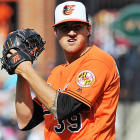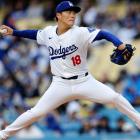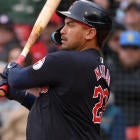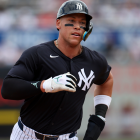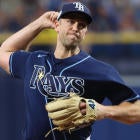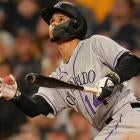It's a lot easier to overreact to early pitching performances than it is with hitters, and for good reason. Every start represents a much larger proportion of a pitchers' season, and we have more tools available to separate skill from luck with pitching in small sample sizes than we do with hitters.
However, that doesn't necessarily mean we should overreact to everything we see from a starter early on. There are plenty of pitchers who go through rough stretches but don't come out the other side as a fundamentally changed pitcher, and overreacting to a few bad starts can be a mistake.
You probably had a few starters on your roster you weren't totally bought into coming into the season but who ended up falling to a point where you had to take them. It's easy to convince yourself to cut those pitchers loose, but I want to mount a defense of six who aren't off to great starts, but who I'm not quite ready to give up on yet.
I wrote about Kevin Gausman's struggles Wednesday, noting that he hasn't been throwing his best pitch -- his splitter -- much at all:
So, it's a curious thing to see him essentially ditch the pitch. It also, strangely, gives me some hope for the future. Gausman hasn't been the pitcher I hoped to see coming into the season because he literally has not been the pitcher I expected to see. Whatever the reason, the key to turning things around for Gausman could be as simple as finding his splitter and leaning on it more.
It may not be a magic bullet. There is probably a good reason Gausman hasn't thrown the pitch often, and we just can't see it from the outside. However, Gausman showed ace upside last season, and the splitter was a key to that. I still believe in his potential because he could still just be a small tweak from finding it.
I'll stay away from Gausman in my starting lineup for now, but we've seen him pitch too well to think about dropping him this early.
Control wasn't much of an issue for Sean Manaea as a rookie, but with a 12.7 percent walk rate through his first 16 1/3 innings, it's been a concern so far. However, he has pared it with increases in groundball rate and strikeout rate, so it's fair to wonder if this might be a tradeoff worth making. Manaea is working outside of the strike zone far more often than he did last season, with his in-zone pitch percentage dropping from 49.7 to 39.0 so far, per PITCHf/x.
If your stuff is good enough, that's one way to rack up swinging strikes and weak contact. You just have to be able to induce swings on those pitches out of the zone, and that's where Manaea is falling short so far. His swing rate against pitches outside of the zone has fallen from 36.6 to 31.3 percent. Manaea's stuff is strong enough to generate swings and misses consistently, and he can probably get away with pitching more in the zone than he has been. Bet on the stuff here, even if the results haven't been great.
I'm starting to worry Velasquez will be the kind of pitcher who shows just enough flashes to make it impossible to ever justify dropping him but never actually pitches well when I start him. He is a bonafide elite strikeout pitcher, with a career rate of 26.9 percent that he has maintained even in the early going this season. However, he continues to have trouble consistently executing, leaving him vulnerable to the sort of meltdowns that are just disastrous for Fantasy purposes.
He has yet to have a start where he puts it all together, as he racked up 17 strikeouts in his first two, but also walked seven and allowed nine runs in nine innings of work across them. He allowed three runs over six innings in a quality start Wednesday, but struck out just two batters, with only two swinging strikes. If Velasquez isn't missing bats, he doesn't do a good enough job keeping the ball on the ground or limiting free passes to survive.
However, it's worth noting that Velasquez hasn't really been throwing his breaking pitches much in the early going, with his curveball and slider usage combined at just 14 percent of his pitches; he used them around 23 percent of the time last season. Velasquez has had trouble generating swings on pitches out of the strike zone especially, but more breaking pitches could remedy that situation. Let's see if he can find them.
Robert Gsellman had an odd start to the season, earning a rotation spot out of spring training, but was still sent to the bullpen to open things up. He made one appearance, and then struggled in a pair of outings to open the season, allowing 11 runs -- seven earned -- in 9 2/3 innings. However, both outings came against the Marlins, and it's fair to wonder if pitchers aren't at a disadvantage if they have to face the same lineup in consecutive starts. It is accepted as general wisdom that pitchers are at a disadvantage when they face batters multiple times in the same start, so the same principle may hold over multiple starts.
Still, Gsellman turned things around Wednesday, allowing three earned runs on six hits and a walk over seven innings, while racking up seven strikeouts. The skills that made him an intriguing sleeper coming into the season are still there -- the hard, heavy fastball he uses to rack up groundballs, and a high-80's slider he can rack up swings and misses with, to go with a changeup and curveball to keep batters honest.
Gsellman was a trendy sleeper coming into the season, but was dropped in plenty of leagues after his first two starts. Hopefully Wednesday's outing was enough to convince you to keep the faith.
Zack Wheeler is still on the long road to recovery, even though he is more than two years removed from Tommy John surgery. His right arm is healthy, and his velocity is pretty much right where it was before the injury. However, the first three starts are a reminder that there's still some work left to do. These competing New York-area newspaper headlines that come up when you search "Zack Wheeler" in Google sum things up nicely:

Wheeler isn't at the point where he can easily pitch deep into games, and he's still trying to find his feel for all of his pitches -- remember, he has thrown just 28 competitive innings since the end of the 2014 season, spring training included. Given those obstacles, 15 strikeouts and only four walks in his first 14 2/3 innings isn't a bad sign. Given his looming innings limit -- around 120 innings -- Wheeler doesn't have a ton of time to find himself, but he still has the upside to be a difference maker for the next 100 innings or so.
We got excited about Taijuan Walker in the offseason amid news that he was working on a new, tighter, harder breaking pitch. His curveball has never been particularly effective, so the addition of a new breaking pitch was viewed as a potential path to Walker figuring out his potential.
So far, that's not what we're seeing. Walker is throwing a slider about 12 percent of the time, though he hasn't ditched the curveball either. Unfortunately, the result has only been that he has two different mediocre breaking pitches to throw instead of one; he has just three swinging strikes on 68 sliders and curveballs combined. Walker's fastball has lost a bit of life over the years, but it has still been an effective pitch, racking up a 16.0 whiff rate. However, he is throwing it less than ever because the addition of the slider has mostly come at the expense of his fastball.
Walker is going about things a different way, but he still looks like the same guy he did in the past. That's not a great sign, given how underwhelming he is, but if I can afford the roster spot, I'm still trying to stash him. I don't want to miss it if the light comes on.
























